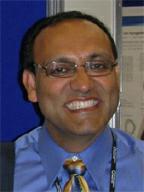Edge Localized Instabilities in Fusion Research Devices: Foe or Friend?
| Event Date: | November 10, 2010 |
|---|---|
| Speaker: | Rajesh Maingi, Ph.D.
Deputy Group Leader and Distinguished R&D Staff Member |
| Speaker Affiliation: | Fusion Energy Division
Oak Ridge National Laboratory |
| Time: | 3:30 p.m. |
| Location: | EE 170 |
Abstract:
The plasma performance in fusion research devices is usually maximized in the so-called High-confinement mode or H-mode discharges. In addition to the improved core plasma performance, steep pressure gradients develop in the edge plasma, which increases the capacity of the plasma to drive internal (non-inductive) currents, but also leads to local instabilities known as edge localized modes or ELMs. ELMs result in periodic ejections of the edge plasma energy, which leads to high, cyclical thermal loads on the plasma facing components. On the other hand, ELMs also eject impurities from the main plasma that helps to maintain plasma performance. ELMs have been observed for 25 years, but new insight has been recently obtained through super-fast cameras that show filaments ejected from the edge plasma, similar to solar flares. This talk will give a introduction to ELM physics, with an emphasis on the many diagnostics used to unveil their complex structure. The prospects for ELM control in existing and future devices will also be discussed.
Brief Bio:
Dr. Maingi is a Distinguished R & D Staff Member in the Experimental Plasma Physics Group of the Fusion Energy Division at Oak Ridge National Laboratory, and a Fellow of the American Physical Society. He received a B.S. and Ph.D. in Nuclear Engineering from N. C. State University in 1987 and 1992 respectively.
From 1992-1997, Dr. Maingi conducted boundary physics research on the DIII-D tokamak in San Diego, CA, with a focus on particle control, power handling, and density limit studies. He was the recipient of a U.S. D.o.E. Fusion Energy Postdoctoral Fellowship from 1992-1995. In 1997 Dr. Maingi joined the staff at Oak Ridge National Lab and continued edge physics research on the DIII-D tokamak. He continues to collaborate with scientists from DIII-D.
Starting in 1996, Dr. Maingi began participating in the physics design of the plasma facing components for the National Spherical Torus Experiment (NSTX) in Princeton, NJ, and began to conduct boundary physics research on the NSTX device in 1999. In addition, Dr. Maingi also collaborated on research with scientists from ASDEX-Upgrade during 1995-1998 and from the TdeV tokamak during 1995-1996. He has been collaborating with scientists from the MAST device in Culham, U.K. from 2003-present, and with scientists from the Alcator C-Mod tokamak from 2005-present.
Dr. Maingi presently leads research in several areas of NSTX, namely power and particle control, H-mode access and characterization, H-mode pedestal characterization, and Edge Localized Modes (ELMs). In addition, Dr. Maingi is the NSTX and overall leader of the U.S.D.o.E. FY 2010 Joint Research Target on SOL width physics, as well as the NSTX leader of the U.S.D.o.E. FY 2011 Joint Research Target on H-mode pedestal physics. Also, Dr. Maingi has served as the Experimental Task group leader in many NSTX physic areas: Boundary Physics (2006, 1999-2001), Boundary Physics deputy (2008-present), the Integrated Scenario Development Group Leader (2007, 2005, 2003) and Transport and Turbulence group leader (2004). Finally, he has served as the NSTX Experiment Run Coordinator (2002), and Deputy Run Coordinator (2001).
Dr. Maingi presently serves as deputy leader of US participation in the International Tokamak Physics Activity (ITPA) pedestal physics working group. He is the co-leader of two separate multi-machine experiments in the ITPA pedestal group: the first between NSTX, DIII-D and MAST, and the second between NSTX, Alcator C-MOD, and MAST.
Dr. Maingi has been appointed to serve on many committees, including: 1) Executive Committee of the Transport task Force (2009-), 2) Member of the Edge Coordinating Committee (2009-), 3) Vice-chair of the Plasma-Material Interface topic for the ReNeW strategic planning process (2008-2009), 4) Member of the DIII-D Program Advisory Committee (2007-2009), 5) the American Physical Society Division of Plasma Physics Program Committee (2006), 6) the Fusion Facilities Assessment Panel (2005), 7) the National Compact Stellarator Experiment (NCSX) Program Advisory Committee (2001-present), and 8) the U.S. D.o.E. Graduate Student Fellowship and Postdoctoral Fellowship Committee (2004, 1999-2001).
Dr. Maingi is first author on 23 refereed journal articles and is a contributing author to over 500 publications. He has made 65 major oral presentations at international and domestic conferences and invited seminars at universities.
2010-11-10 15:30:00 2010-11-10 16:30:00 America/Indiana/Indianapolis Edge Localized Instabilities in Fusion Research Devices: Foe or Friend? EE 170

